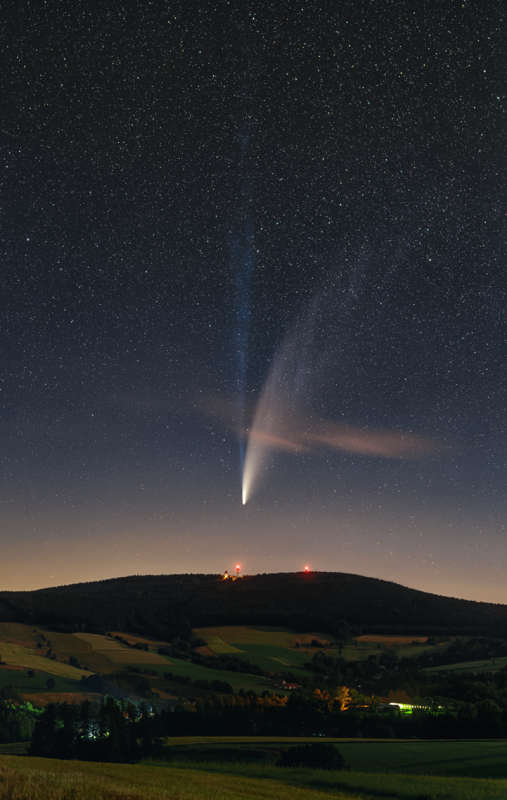
|
Credit & Copyright: Petr Horalek
Explanation:
This Comet NEOWISE (C/2020 F3) now sweeps through
our fair planet's northern skies.
Its
long
tails
stretch across this deep skyview from Suchy Vrch, Czech Republic.
Recorded on the night of July 13/14,
the composite of untracked foreground
and tracked and filtered sky exposures
teases out details in the comet's tail not visible to the
unaided eye.
Faint structures extend to the top of the frame,
over 20 degrees from the comet's bright coma.
Pushed out by the pressure of
sunlight itself, the broad curve of the comet's yellowish
dust tail is easy to see by eye.
But the fainter, more bluish tail is separate from the
reflective
comet dust.
The fainter tail is an ion tail, formed as ions from the
cometary coma are dragged outward by magnetic fields in the solar wind
and fluoresce in the sunlight.
Outbound
NEOWISE is climbing
higher in northern evening skies,
coming closest to Earth on July 23rd.
Notable Images of Comet NEOWISE Submitted to APOD:
|| July
15
|| July
14
|| July
13
|| July
12
|| July
11
|| July
10 & earlier ||
|
January February March April May June July August September October November December |
| ||||||||||||||||||||||||||||||||||||||||||||||||
NASA Web Site Statements, Warnings, and Disclaimers
NASA Official: Jay Norris. Specific rights apply.
A service of: LHEA at NASA / GSFC
& Michigan Tech. U.
Based on Astronomy Picture
Of the Day
Publications with keywords: comet - comet tail
Publications with words: comet - comet tail
See also:
- APOD: 2025 December 1 Á 3I ATLAS: Tails of an Interstellar Comet
- APOD: 2025 November 25 Á Comet Lemmon and the Milky Way
- 3I/ATLAS: A View from Planet Earth
- APOD: 2025 November 17 Á Comet Lemmons Wandering Tail
- APOD: 2025 September 30 Á Comet Lemmon Brightens
- APOD: 2025 September 29 Á Two Camera Comets in One Sky
- APOD: 2025 September 26 Á A SWAN an ATLAS and Mars
